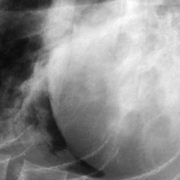Perioperative hypoxemia – What do I do?
Amber Hopkins, DVM, cVMA, DACVAA
Veterinary Specialty Hospital, San Diego, CA
Posted on 2017-04-25 in Anesthesia & Analgesia
Hypoxemia refers to abnormally low levels of oxygen in the blood, whereas hypoxia is defined as abnormally low oxygenation of the tissues or the body as a whole. Appropriate arterial levels of oxygen are important for maintaining normal tissue oxygenation and therefore normal cellular metabolism and overall cellular function. Inadequate tissue oxygenation leads to cellular dysfunction and eventually cell death. For this reason, close monitoring of SpO 2 and end tidal CO 2 perioperatively is important and abnormalities investigated and addressed.
Hypoxemia can be divided into mild, moderate and severe. Mild hypoxemia is an SaO 2 of 94–96% and PaO 2 of 70–90 mmHg. Moderate is SaO 2 91–94% and PaO 2 of 60–70 mmHg. Severe hypoxemia is an SaO 2 of < 91% and PaO 2 < 60 mmHg at room air. There are generally five main causes of hypoxemia: decreased fraction of inspired oxygen (FiO 2 ), hypoventilation, V/Q mismatch, diffusion impairment and shunting. Room air is comprised of 21% oxygen, therefore a normal patient breathing only room air should have a PaO2 of approximately 100 mmHg (PaO 2 = 5 x FiO 2 ). An intubated patient, receiving 100% oxygen should have a PaO 2 of > 400 mmHg, therefore a patient with an accurately low SpO 2 or documented low PaO 2 is quite concerning. Reasons for low FiO 2 in an anesthetized patient may be due to disconnection of oxygen source (e.g. oxygen flow meter turned off, oxygen tank depleted, etc.), obstruction of breathing circuit/endotracheal tube, or excessive inspired concentration of carbon dioxide from an oxygen flow rate too low (non-rebreathing system) or a non-functional expiratory valve. This should always be the first thing checked should your patient suddenly become hypoxemic.
Hypoventilation reduces the amount of oxygen delivered to the alveoli during ventilation. Common intraoperative reasons for hypoventilation include low respiratory rate or small tidal volume breathing. Causes include drug related, obesity, pregnancy, pain, intrapleural mass/fluid, neurologic disease or excessive compression of chest from external devices such as a vacuum pack. The underlying cause should be identified and directly addressed first. This may include additional pain medication, thoracocentesis, removing restrictive materials, patient repositioning (e.g. Reverse Trendelenburg), etc. This can be followed by assisted or mechanical ventilation.
The most common cause of hypoxemia is ventilation and perfusion (V/Q) mismatch. Ventilation and perfusion (V/Q) should ideally be matched (V/Q of 1) at the level of the alveoli. V/Q mismatch occurs when ventilation is in excess of perfusion or vice versa. Causes of V/Q mismatch are commonly associated with increases in dead space (e.g. excessively long ET tubes, low cardiac output/blood pressure, PTE), asthma, atelectasis and hypoventilation. Improvement of blood pressure and pulmonary perfusion, recruitment maneuvers, mechanical ventilation and removal of excessive mechanical dead space are the primary treatment options. Improvements in blood pressure can be done by decreasing the concentration of inhalant, fluid boluses, maintenance of a normal heart rate and inotropic or vasopressor therapy.
Diffusion impairment is less common in the anesthetized patient but is as a result of the inability for oxygen and/or carbon dioxide to diffuse across the alveolar membranes to and from the arterial system. Pulmonary fibrosis, pulmonary edema, pulmonary vasculitis and emphysema would be included in this classification. Treatment includes management of the underlying cause. Mechanical ventilation may be indicated in these patients but due to abnormal alveolar anatomy, protective lung strategies (low tidal volume breathing) should be considered in these patients.
Lastly, right to left shunting which is largely considered a severe form of V/Q mismatch can lead to severe hypoxemia. Intracardiac shunts and intrapulmonary vascular shunts would be classic examples and again and management of the underlying cause should be the priority but maintaining normal blood pressure is also key. If you can remember the five primary causes of hypoxemia, identification of the underlying cause should not be terribly complicated in most of your routine cases. In general, routine anesthetic patients struggling with a low SpO 2 and identified or suspected hypoxemia will fall into the first three categories, low FiO 2 , hypoventilation and V/Q mismatch. Always check your patient and equipment first, improve perfusion if indicated and improve respiratory rate and/or tidal volume if appropriate. Should you continue to struggle, thoracic radiographs and cardiac workup may be indicated. And finally, never ignore or underestimate the significance and value of your SpO 2 and EtCO 2 monitors, they may be the first sign of pending troubles.
About the author
|


 Dr. Amber Hopkins is a 2007 graduate of the Ross University School of Veterinary Medicine. She completed a one-year small animal rotating internship at Bay Area Veterinary Specialists in San Leandro, CA, followed by a three-year residency in anesthesia at the University of Pennsylvania. During her residency, she specialized in all areas of anesthesia and pain management in large animal, small animal, small exotic and zoo animals. Dr. Hopkins’s areas of particular interest are critical care anesthesia, exotics anesthesia and all aspects of pain management, including acute and chronic pain and client education. Dr. Hopkins is also certified in acupuncture, to further incorporate both conventional and complementary methods for treatment and management of pain. In her spare time, Dr. Hopkins enjoys hiking with her two mixed breed dogs, volleyball, surfing, and SCUBA diving.
Dr. Amber Hopkins is a 2007 graduate of the Ross University School of Veterinary Medicine. She completed a one-year small animal rotating internship at Bay Area Veterinary Specialists in San Leandro, CA, followed by a three-year residency in anesthesia at the University of Pennsylvania. During her residency, she specialized in all areas of anesthesia and pain management in large animal, small animal, small exotic and zoo animals. Dr. Hopkins’s areas of particular interest are critical care anesthesia, exotics anesthesia and all aspects of pain management, including acute and chronic pain and client education. Dr. Hopkins is also certified in acupuncture, to further incorporate both conventional and complementary methods for treatment and management of pain. In her spare time, Dr. Hopkins enjoys hiking with her two mixed breed dogs, volleyball, surfing, and SCUBA diving.








